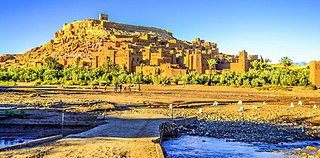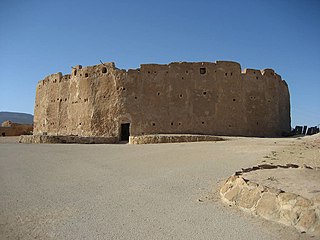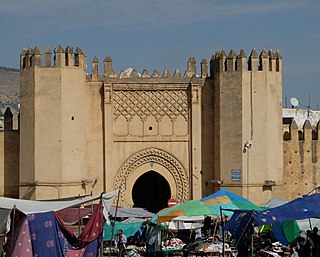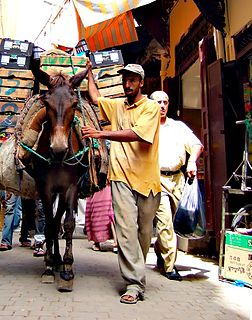 W
WAït Benhaddou is a historic ighrem or ksar along the former caravan route between the Sahara and Marrakech in present-day Morocco. It is considered a great example of Moroccan earthen clay architecture and has been a UNESCO World Heritage Site since 1987.
 W
WBab Ksiba is a gate in Marrakech, Morocco. Bab Ksiba and another more famous gate further north, Bab Agnaou, served as entrances to the royal Kasbah (citadel) in the southern part of the medina of Marrakech, a UNESCO World Heritage Site.
 W
WBen Hmida Mosque, is a Tunisian mosque located in the north of the medina of Tunis, in Bab Souika suburb.
 W
WBeni Hammad Fort, also called Al Qal'a of Beni Hammad is a fortified palatine city in Algeria. Now in ruins, in the 11th century, it served as the first capital of the Hammadid dynasty. It is in the Hodna Mountains northeast of M'Sila, at an elevation of 1,418 metres (4,652 ft), and receives abundant water from the surrounding mountains. Beni Hammad Fort is near the town of Maadid, about 225 kilometres (140 mi) southeast of Algiers, in the Maghreb.
 W
WThe Calahorra tower is a fortified gate in the historic centre of Córdoba, Spain. The edifice is of Islamic origin.
 W
WChouara Tannery is one of the three tanneries in the city of Fez, Morocco. It is the largest tannery in the city and one of the oldest. It is located in the Fes el Bali, the oldest medina quarter of the city, near the Saffarin Madrasa along the Oued Fes. Since the inception of the city, the tanning industry has been continually operating in the same fashion as it did in the early centuries. Today, the tanning industry in the city is considered one of the main tourist attractions. The tanneries are packed with the round stone vessels filled with dye or white liquids for softening the hides. The leather goods produced in the tanneries are exported around the world.
 W
WEl Gour, or Bazina du Gour, is an ancient archeological site located in the Fès-Meknès region of northern Morocco. Estimates date the site at being constructed some time between the 4th and 2nd centuries BCE.
 W
WEl Fell Mosque or 'mosque of the chance' is a small mosque located in the Azzafine hood in the Medina of Tunis.
 W
WGasr Al-Hājj is a huge fortified granary of circular shape built in the 7th century AH/13th century AD by Abdallah Abu Jatla. It is located in Libya on the Tripoli-'Aziziya-Al Jawf route in Libya about 130 km from Tripoli. It was built to serve as granary for families from the surrounding area in return for quarter of their crops, which, it is said, the owner had endowed as a waqf for teaching Qur'an and Islamic related subjects to the people of the area. The building originally comprised 114 chambers, which could be the number of the subscribing families during the time of construction. It is also speculated that the number 114 was used symbolically to reflect the number of Sura in the Qur'an, a view widely accepted by villagers in the region nowadays. The number of chambers as of now, is 119, as result of splitting 10 chambers due to inheritance disputes. Other changes include the addition of 29 cellars.
 W
WGhardaïa is the capital city of Ghardaïa Province, Algeria. The commune of Ghardaïa has a population of 93,423 according to the 2008 census, up from 87,599 in 1998, with an annual growth rate of 0.7%.
 W
WA ghorfa is a vaulted room used by Berbers for storing grain. They are often stacked as multistory structures, sometimes reaching four stories high. Traditionally, the rooms were grouped together as a ksar, a fortification used by Berber villages in the Maghreb to store large amounts of grain.
 W
WThe Great Mosque of Salé is a mosque in Salé, Morocco. Covering an area of 5,070 m2 (54,600 sq ft), it is the third-largest mosque in Morocco, and was originally built between 1028 and 1029. It has been destroyed and rebuilt several times since the original construction. It was built in Almoravid and Almohad architectural styles, and the mosque features nine gates. It was severely damaged in the Bombardment of Salé of 1851, and was briefly closed during the French protectorate in Morocco.
 W
WJedars are thirteen Berber mausoleums located south of Tiaret city in Algeria. The name is derived from the Arabic: جدار jidār (wall), which is used locally to refer to ancient monumental ruins. These pre-Islamic tombs date from Late Antiquity.
 W
WThe Kasbah An-Nouar or Kasbah Filali is a walled district and former military enclosure in the old medina of Fez, Morocco. Its name means "citadel of the flowers", but it is sometimes also referred to as Kasbah Filala and Kasbah Chorfa. It is one of several fortified military enclosures or kasbahs that were built around the old city of Fez across different periods.
 W
WKasbah Gnawa, also referred to as: Kasbah of Gnaouas or Ismailian Kasbah is a kasbah located in the city of Salé in Morocco, and is the only one on the right bank of the Bou Regreg river.
 W
WKsar or qsar, plural ksars, qsars, ksour or qsour, is the North African term for "fortified village," from Arabic qaṣar (قَصَر), itself possibly loaned from Latin castrum. The term generally refers to a Berber fortified village.
 W
WThe Libyco-Punic Mausoleum of Dougga is an ancient mausoleum located in Dougga, Tunisia. It is one of three examples of the royal architecture of Numidia, which is in a good state of preservation and dates to the 2nd century BC. It was restored by the government of French Tunisia between 1908-10.
 W
WMadghacen, also spelled Medracen or Medghassen or Madghis is a royal mausoleum-temple of the Berber Numidian Kings which stands near Batna city in Aurasius Mons in Numidia, Algeria.
 W
WThe Madrasa Thaalibia, is a madrasa located in Algiers, Algeria. It was founded on 17 October 1904 by Charles Jonnart and subsequently became one of the leading spiritual and educational centres of Algeria.
 W
WThe Marinid Walls of Algeciras are city walls located in Algeciras, Spain. They were built by the Marinid dynasty. The walls were declared Bien de Interés Cultural in 1985.
 W
WThe Medina of Salé, or Salé old town is the medina quarter and the oldest walled part in the city of Salé in Morocco. It is classified as a national cultural heritage since October 1914, and is considered as one of the oldest medinas of Morocco.
 W
WA medina quarter is a distinct historical city section found in a number of North African cities, and in Malta. A medina is typically walled, with many narrow and maze-like streets. The word "medina" itself simply means "city" or "town" in modern-day Arabic. It is cognate with the Aramaic-Hebrew word referring to a city or populated area.
 W
WMoorish architecture, is a style within Islamic architecture which developed in the western Islamic world, which included al-Andalus, and the Maghreb. The term "Moorish" comes from the Western European designation of the Muslim inhabitants of these regions as "Moors", which itself comes from Latin "Mauri", originally a designation of the inhabitants of the Berber kingdom of Mauretania. Some scholars also use the term Western Islamic architecture or "architecture of the Islamic west" for this subject.
 W
WThe Castle of Paderne is an ancient fortification located in the civil parish of Paderne, municipality of Albufeira, in the Portuguese Algarve. It was constructed in the later 12th century by Berbers, in an area around 7.5 kilometres (4.7 mi) inland. The edifice is located just 8.2 kilometres (5.1 mi) from the resort town of Albufeira, along a bend in the Quarteira River. It is believed to be one of the original castles that occupy the shield of the Portuguese national flag.
 W
WThe Royal Mausoleum of Mauretania is a funerary monument located on the road between Cherchell and Algiers, in Tipaza Province, Algeria. The mausoleum is the tomb where the Numidian Berber King Juba II and the Queen Cleopatra Selene II, sovereigns of Numidia and Mauretania Caesariensis, were allegedly buried. However, their human remains have not been found at the site, perhaps due to tomb raiding.
 W
WThe Torre de la Plata is an octagonal military tower in Andalusia, located in present-day Seville, southern Spain. It was constructed by the Almohad Caliphate.